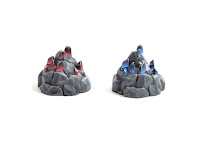I'm happy to report that for the third time evar I've hit the magical 365 painted figs in a year mark and hopefully I won't be doing this super often in the future. Beyond that, I hit each of the major bucket goals with a pseudo-miss on the squishy "six of the high quality ones should be NMM" which I honestly forgot that I'd added. This is why I don't like long laundry lists of things.
Week 1: Reaper Profane Altar and Books, Balzador, Cleric, Aravir, Elf Ranger, Khanag the Slayer, Bryn, Half Elf Rogue, Estra, Iconic Spiritualist
Week 2: Arjan, Dragonborn Fighter and Heskan, Dragonborn Wizard from D&D boardgames, Blacklist Fantasy Series 1 female dragonkin warlock, male dragonkin warrior, demonkin assassin, demonkin sorcerer
Week 3: Vistra Dwarf Fighter, Alaeros, Northland Fighter, Drizzt, Jarlaxle, Cattie-Brie from D&D boardgames, Half-Elf Warlock Jilsa Rennwin from DnD is a Woman
Week 4: Blacklist Fantasy Series 1 Street Vendor, Female Elf Barbarian, Male Half Elf Bard, Male Elf Bard, Female Human Barbarian, Female Elf Ranger, Dungeons and Lasers 2xBig Mushrooms, 1xmelty statue
Week 5: Blacklist Fantasy Series 1 Male Human Cleric, Vampire Lord, Female Human Paladin, Lich Lord, Male Dwarf Monk, Female Human Constable, Male Elf Paladin, Male Elf Rogue, Half Elf Fighter
Week 6: Blacklist Fantasy Series 1 Half Orc Bard, Inkeeper, Male Human Druid, Female Half Elf Druid, Male Elf Wizard (high quality #1), Female Human Fighter (high quality #2), Female Half Elf Wizard (high quality #3)
Week 7: Blacklist Fantasy Series 1 Shambling Mound, Demon Lord, Ogre, Troll, Female Giant (large #1), Dragon (large #2)
Week 8: Onyx, Ironborn Fighter from DnD is a Woman, Reaper Bones Maggotcrown Juggernaut, Devil, and Cave Troll, Nolzur's Umber Hulk
Week 9: RN EStudio Aurielle - Female Ranger (high quality #4)
Week 10: Artisan Guild Wappelious Spellbrush and Orc Barbarian - B (Male) Modular, Reaper Tazythas, Dragonfolk Rogue, Duncan Shadow Fox Folk / Kitsune Multipart Kit, DnD is a Woman Amalya, Tabaxi Monk, Galaad Fairy 02 (high quality #5)
Week 11: Hail Caesar Imperial Romans: Plastic Scorpion + attendant operators (painted in a previous year).
Week 12: Hail Caesar Imperial Roman Western Auxiliary Archers
Week 13: Hail Caesar Imperial Roman Eastern Auxiliary Archers
Week 14, Week 15, Week 16: Oshounaminis Free Flying Worms and Free Small Worms
Week 17: Reaper Fulumbar Ironhand, Chainmail Ravilla Gray Elf Duelist and Gray Elf Wizard
Week 18: Lion's Tower Lilly, Arch White Mage, 2x Reaper Dread Knights, RN Estudio Lydia the Lionness (high quality #6)
Week 19: Reaper Tidal Lurker, Thrasher Snail, Cyclops
Week 20: Kingdom of Talarius War Mages
Week 21: Reaper Bones Annoyed Rocky (high quality #7)
Week 22: Reaper Bones Treasure Rocky and Flying Rocky (high quality #8 and #9)
Week 23: Reaper Bones Scheming Rocky and Sneaky Rocky (high quality #10 and #11)
Week 24: Reaper Bones 5 Treasure Pile and Artisan Guild Orc Barbarian D (high quality #12)
Week 25: Cyberforge Liza Thorn, Cree Chief Judah Starwalker, and Ghost of Kyiv, Papsikels Pam Pam Flores, Reaper Asanis Mercury Flyer,
Week 26: Women & Sci Fi Smuggler, Twin Goddess TurningGear, Cyberforge Bonnie Gun, Suzanne Vega, and Cuddy Grey (high quality #13)
Week 27: Robotech RPG Tactics Regault Battle Pods, Recon Scout Pod, Zentradi Artillery Pod, Zentradi Recovery Pod
Week 28: Cyberforge O-REN, Kimiko, Jenny Silverleg, Wargames Atlantic International Women's Day Free Figure, Moid Female Mercenary
Week 29: Vae Victis Human Fighter, Reaper Bones Female Minotaur, Weapon Rack, Broken Cork Pillars
Week 30: Dungeons & Lasers tables, assorted sarcophogi, stone chairs
Week 31: DnL portals, creepy statues, melty statues, dragon pillars, dwarven hearths
Week 32: DnL foot stools, cabinets, park benches, wooden tables
Week 33: DnL stargate portal, hologram displays, office chairs, egg clusters, l-shaped concrete barriers
Week 34: DnL guillotines, x-shaped restraints, iron maidens, spike trap, assorted torture devices
Week 35: DnL small rubble wall, mine carts, shovel piles, axe skulls, squashy skeletons, wheel barrows
Week 36: DnL globey things, lanterns, dynamite boxes, big miner skulls, pickaxe piles
Week 37: DnL beds, stills, casks, scroll piles, book piles, leg lecterns
Week 38: Zierzo Miniatures Space Cowgirl, Papsikels Future Savior and Space Captain, Hivemind Minis Vanguard Droids, Hexy Studios Bios Equalizer Bots
Week 39: DnL weapon rack, armor racks, assorted fountains, anvils, axe stumps, grinding stones
Week 40: DnL bear traps, boney thrones, candle skull, chest
Week 41: DnL Sci-Fi tiles
Week 42: DnL assorted barrels, satellite dishes, sci-fi trunk, safes, pipes
Week 43: DnL legally distinct companion cubes, transporder pads, rockets, atomic bombs, robot arm, walking turrets
Week 44: DnL sci-fi hatches, floor grates, ammo bins, sci-fi bridges, Geiger-esque thing
Week 45: Bad News Tower (foam structure)
Week 46: DnL big map display things, computer desks, old timey terminals, globe projection tables, atomic whirl retro TVs, vending machines
Week 47: DnL robot cult idol statues, legally distinct daleks, legally distinct star gates, yellow plunger-y things
Week 48: DnL busted up bar signs, fuel pumps, crypt markers, mimic shelves, gemstone clusters
Week 49: DnL assorted cauldrons, crystal-y formations, bed mimics, creepy mushrooms, creepy paintings, dude in a medical bed, busted up helmets, a marine having a bad day, ammo boxes
Week 50: DnL bridges, busted up fantasy corners, busted up sci-fi corners
Week 51: Papsikels Future Savior and Space Captain, Titan City Police Force Captain Roy "Donuts" Wales and Officer Roy Blunt, The Master Forge Paladin Aasimar
Week 52: Lion's Tower Captain Amara, Reaper Kassandra of the Blade, Familiars Pack 1, Prince Nicholas, Darksword Pi-Rat, Tri-Fin Adventurer - Fighters and Sorcerers, Nolzur's Wyvern and Young Blue Dragon
























